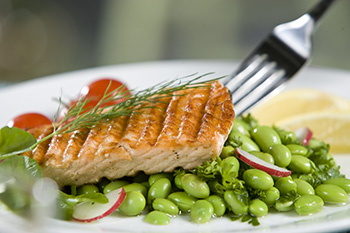Eating Heart-Healthy Foods
Eating has a big impact on your heart health. In fact, eating healthier can improve several of your heart risks at once. For instance, it helps you manage weight, cholesterol, and blood pressure. Here are ideas to help you make heart-healthy changes without giving up all the foods and flavors you love.
Getting started
-
Talk with your healthcare provider about eating plans, such as the DASH or Mediterranean diet. You may also be referred to a dietitian. Ask a partner, family member, or friend to join you for mutual support.
-
Change a few things at a time. Give yourself time to get used to a few eating changes before adding more.
-
Work to create a tasty, healthy eating plan that you can stick to for the rest of your life.
Goals for healthy eating
Below are some tips to improve your eating habits:
-
Limit saturated fats and trans fats. Saturated fats raise your levels of cholesterol, so keep these fats to a minimum. They are found in foods such as fatty meats, whole milk, cheese, and palm and coconut oils. Avoid trans fats because they lower good cholesterol as well as raise bad cholesterol. Trans fats are most often found in processed foods, such as pastries, cookies, pies, muffins, fried foods, stick margarines, and shortening.
-
Reduce how much sodium (salt) you have. Eating too much salt may increase your blood pressure. Limit your sodium intake to 2,300 milligrams (mg) per day (the amount in 1 teaspoon of salt), or less if your healthcare provider recommends it. Dining out less often and eating fewer processed foods are two great ways to decrease the amount of salt you consume. At home, flavor your foods with other spices and herbs instead of salt.
-
Managing calories. A calorie is a unit of energy. Your body burns calories for fuel, but if you eat more calories than your body burns, the extras are stored as fat. Your healthcare provider or dietitian can help you create a diet plan to manage your calories. This will likely include eating healthier foods and getting regular exercise. To help you track your progress, keep a food diary to record what you eat and how often you exercise.
Choose the right foods
Aim to make these foods staples of your diet. If you have diabetes, you may have different recommendations than what is listed here:
-
Fruits and vegetables provide plenty of nutrients without a lot of calories. At meals, fill half your plate with these foods. Choose between fresh, frozen, canned, or dried fruits and vegetables without added sauces, salt, or sugars. Split the other half of your plate between whole grains and lean protein.
-
Whole grains are high in fiber and rich in vitamins and nutrients. Good choices include whole-wheat bread, pasta, quinoa, oats, and brown rice. Make at least half of your grains whole grains.
-
Lean proteins give you nutrition with less fat. Good choices include fish, skinless chicken and turkey, and beans. Draining the fat from cooked ground meat is another way to reduce the amount of fat you eat.
-
Low-fat and nonfat dairy provide nutrients without a lot of fat. Try low-fat or nonfat milk, cheese, or yogurt.
-
Healthy fats can be good for you in small amounts. These are unsaturated fats, such as olive oil, avocado, nuts, seeds, and fish. Try to have at least 2 servings per week of fatty fish, such as salmon, sardines, mackerel, rainbow trout, and albacore tuna. These contain omega-3 fatty acids, which are good for your heart. Flaxseed and walnuts are other sources of heart-healthy fats.

More on heart-healthy eating
Read food labels
Healthy eating starts at the grocery store. Be sure to pay attention to food labels on packaged foods. Look for products that are high in fiber and protein and low in saturated fat, added sugars, and sodium. Avoid products that contain trans fat. And pay close attention to serving size. For instance, if you plan to eat 2 servings, double all the numbers on the label.
Prepare food right
A key part of healthy cooking is cutting down on added fat, sugar, and salt. Look on the Internet for lower-fat, lower-sodium recipes without a lot of added sugars. Also try these tips:
-
Remove fat from meat and skin from poultry before cooking.
-
Skim fat from the surface of soups and sauces.
-
Broil, roast, boil, bake, steam, grill, air fry, or microwave food without added fats.
-
Choose ingredients that spice up your food without adding calories, fat, sugar, or sodium. Try these items: horseradish, hot sauce, lemon zest and juice, garlic, onion, mustard, nonfat salad dressings, and vinegar. Small amounts of olive oil-based vinaigrettes are OK, too. For salt-free herbs and spices, try basil, cilantro, cinnamon, cumin, paprika, pepper, and rosemary.
Online Medical Reviewer:
Brittany Poulson MDA RDN CD CDE
Online Medical Reviewer:
Heather M Trevino BSN RNC
Date Last Reviewed:
9/1/2025
© 2000-2025 The StayWell Company, LLC. All rights reserved. This information is not intended as a substitute for professional medical care. Always follow your healthcare professional's instructions.